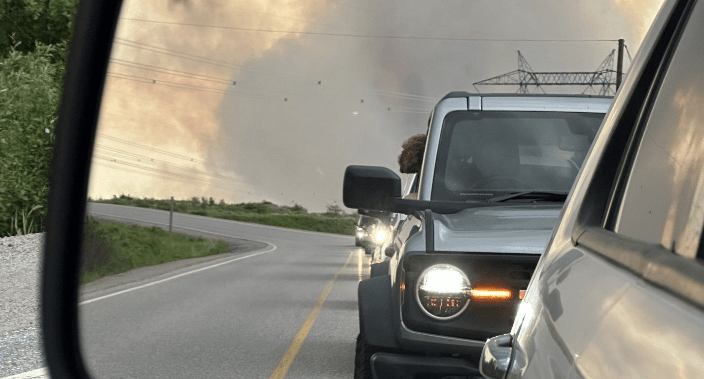Officials in central Labrador say the wildfire threatening the evacuated town of Churchill Falls remained stable Saturday, but there was no sign of significant rainfall in the forecast until Tuesday night.
As a result, the 500 residents ordered to leave the community on Wednesday were left wondering when they would be allowed to return home.
“Right now we’re not giving any estimate on a time of return for the people of Churchill Falls,” the province’s forest fire duty officer, Mark Lawlor, said in an interview Saturday.

Vehicles leave Churchill Falls, N.L., under a threat of a wildfire in a Wednesday, June 19, 2024 handout photo.
THE CANADIAN PRESS/Robert Da
A Quebec water bomber, shown here in this handout photo from Thursday, June 20, 2024, sits at the Happy Valley-Goose Bay airport, ready to help battle wildfires in central Labrador.
THE CANADIAN PRESS/HO-Hunter Wilson
Municipal officials in Churchill Falls were telling residents it might be a long wait.
“With the timeframe of the evacuation order being unknown, and residents displaced in temporary accommodations, we want to help you prepare for possible longer-term solutions,” the town’s website says.
Part of that preparation involves officials drawing up a list of residents who are staying in Happy Valley-Goose Bay, a three-hour drive to the east, and in Labrador City and Wabush, a three-hour drive to the west.
The email you need for the day’s
top news stories from Canada and around the world.
The town says one member of every displaced family must register with the municipality, which will enable the town to pass along further information about the fire, which is only six kilometres from Churchill Falls.
Meanwhile, Lawlor said the Mount Hyde Lake fire started acting up Friday afternoon, but the flare-up was brought under control.

“A section of that fire started exhibiting … some tree candling, and there was some ground fire as well,” he said, adding that waterbombers quickly doused the flames. “That section of the fire is quiet. There’s been no big flare-up or open flames there. It’s stable right now.”
Still, Lawlor said the weather forecast for Saturday evening had changed for the worse, with gusts expected to reach 40 kilometres per hour, increasing the risk of spreading flames. But that bad news was offset by Environment Canada’s prediction that thunderstorms could move into the area overnight.
“If we get those thundershowers, that certainly will aid the firefighters and waterbombers in their task,” Lawlor said. But thunderstorms can be notoriously fickle when it comes to when and where they unload downpours, he said.
“Overcast skies do help,” Lawlor said, adding that cool temperatures at night were also helping. “It keeps fire behaviour down.”
During the next three days, the Churchill Falls area can expect a mix of sun and clouds, and daytime temperatures ranging between 19 C and 25 C. That means more “extreme fire behaviour” is possible, Lawlor said.

Newfoundland and Labrador Hydro, the utility that operates the massive Churchill Falls hydroelectric generating station, issued a statement saying the fire was still burning on the south side of the Churchill River, which stands between the fire and the town.
“Plant operations remain unaffected at this time and is not at immediate risk,” the Crown-owned utility said in a statement released early Saturday.
Eight amphibious waterbombers were attacking the 15-square-kilometre fire, which started on June 13 then grew rapidly a week later, prompting the evacuation order. Four of the aircraft are from the province. On Thursday and Friday, two arrived from Quebec, and another two came from Ontario.

Town officials said fire suppression efforts have kept the fire from growing.
“Despite windy conditions, fire crews were able to take effective action on flare-ups.”
On Saturday morning, Premier Andrew Furey issued a brief, upbeat statement on social media.
“Thank you once again to all first responders for the unwavering and stellar work battling the wildfire near Churchill Falls, and others in the province,” Furey wrote. “Your efforts have been effective.”
While the generating station was operating as usual, the utility issued a statement Saturday saying there was concern that smoke from the blaze could affect insulators on the power lines, causing “trips” that could shut down the flow of electricity.
–with files from Alessia Simona Maratta, Global
© 2024 The Canadian Press





